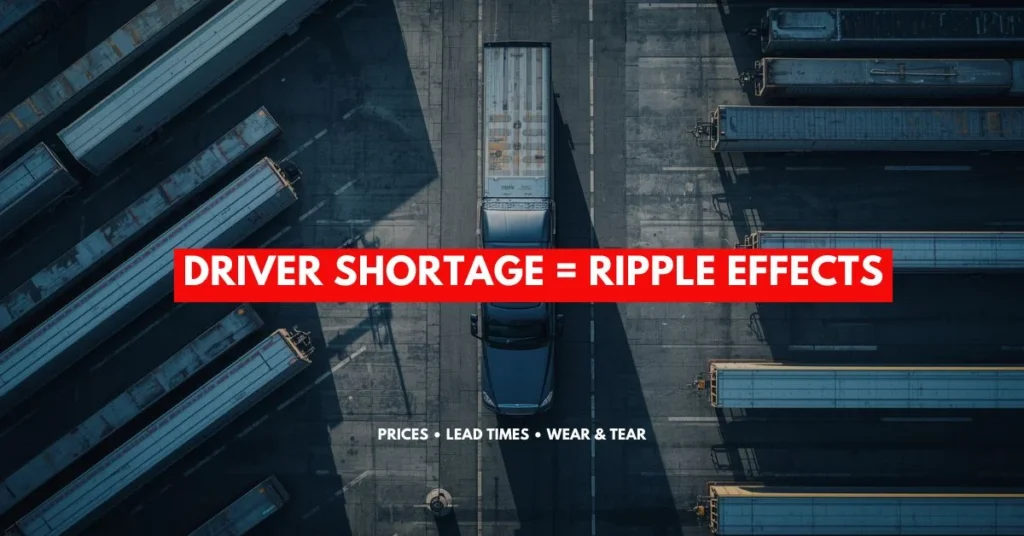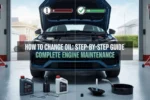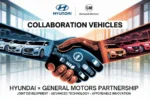The U.S. trucking industry is the backbone of commerce. Nearly 72% of all freight in the country is moved by trucks, according to the American Trucking Associations (ATA). Yet, one challenge continues to dominate headlines and disrupt operations from coast to coast: the Trucking Industry Driver Shortage Impact.
This shortage isn’t just a problem for logistics companies—it affects manufacturers, retailers, small businesses, and even vehicle owners looking to keep their trucks on the road. Let’s break down what’s happening, why it matters, and how companies and individuals can adapt.

Understanding the Driver Shortage Crisis
The driver shortage has been brewing for over a decade, but it has reached unprecedented levels in recent years. The ATA reported that in 2024 the U.S. faced a shortfall of more than 80,000 drivers, and projections suggest this number could surpass 160,000 by 2030 if trends continue.
Contributing Factors:
- Aging Workforce – The average age of truck drivers is about 47, with many nearing retirement.
- Lifestyle Challenges – Long hours away from home, sedentary work, and demanding schedules discourage younger generations.
- Regulatory Barriers – Interstate drivers must be at least 21, limiting the pool of new entrants.
- Pandemic Fallout – COVID-19 accelerated retirements and reshaped labor priorities.
- Competition from Other Industries – Sectors like construction and warehousing often offer local jobs with better work-life balance.
Why Drivers Are Leaving (And Why New Ones Aren’t Coming)
One key reason is a growing age gap in driver demographics. The average commercial driver is nearing retirement age, while younger generations increasingly seek careers that offer better work-life balance and don’t require extended time away from home. Federal regulations, while necessary for safety, have also made the profession less attractive by limiting driving hours and reducing potential earnings.
The lifestyle challenges are real. Long-haul drivers spend weeks away from family, deal with irregular schedules, and face increasing regulatory pressures. Meanwhile, local delivery and short-haul positions often can’t compete with warehouse and distribution center wages that offer employees the chance to go home every night.
Trucking Industry Driver Shortage Impact on Supply Chains
Few industries escape the ripple effects of this shortage.
- Delivery Delays – Retailers struggle to keep shelves stocked, and businesses face longer lead times.
- Rising Costs – Freight rates climb due to high demand and limited capacity. These costs often pass down to consumers.
- Strain on Small Fleets – Owner-operators and small trucking firms face tougher competition for talent.
- Pressure on Equipment – Fewer drivers means existing trucks are pushed harder, increasing wear and tear.
Example: A grocery chain may see fresh produce delayed by just two days—enough to cause spoilage, price increases, and customer dissatisfaction.

What This Means for Truck Owners and Fleet Managers
When demand is high and drivers are scarce, every truck on the road counts. Fleets are extending the service lives of their vehicles, and independent truckers are keeping their rigs running longer to capture available work.
This naturally leads to:
- More frequent breakdowns
- Greater demand for replacement parts
- Increased interest in cost-effective solutions like used engines and transmissions
The Role of Used Engines and Transmissions in Keeping Trucks Rolling
Here’s where companies like Tagore Autoparts step in. With the Trucking Industry Driver Shortage Impact making every operational truck vital, reliable powertrain components are essential.
A quality used engine or transmission can:
- Extend a truck’s service life by years.
- Reduce downtime compared to waiting on new parts backordered due to supply chain disruptions.
- Save owners 40–60% compared to new OEM replacements, without sacrificing performance when sourced from trusted suppliers.
Table: New vs. Used Engines & Transmissions
| Factor | New OEM Engine/Transmission | Quality Used Engine/Transmission |
| Cost | Highest upfront investment | 40–60% lower upfront cost |
| Availability | Often on backorder due to supply chain | Readily available from reputable suppliers |
| Warranty | Manufacturer warranty (varies) | Limited but reliable warranties offered |
| Downtime | Weeks/months if waiting on stock | Shorter turnaround—get back on the road faster |
| Best For | Brand-new fleets, long-term planned purchases | Extending truck life, urgent repairs, cost-conscious owners |
How the Driver Shortage Fuels Maintenance Demand
With fewer drivers to spread the workload, existing trucks often face higher mileage and heavier usage. That translates to:
- More engine stress – Long hauls, hot climates, and heavy loads increase the risk of failure.
- Transmission wear – Frequent shifting under load leads to breakdowns.
- Preventive maintenance gaps – Short-handed fleets sometimes skip recommended servicing, accelerating failures.
Pro tip: If your truck is already logging 500,000+ miles, now’s the time to plan ahead. Having access to a reliable used engine or transmission can mean the difference between a profitable job and costly downtime.
Regional Variations in the Shortage Impact
The trucking industry driver shortage impact doesn’t affect all regions equally. Understanding these variations helps explain why some areas face more severe challenges:
| Region | Shortage Severity | Key Factors | Adaptation Strategies |
| Southeast | Very High | Major ports, distribution centers | Premium driver pay, sign-on bonuses |
| Midwest | High | Manufacturing corridor | Local driver programs, improved benefits |
| Southwest | Moderate-High | Border trade, energy sector | Specialized training, retention programs |
| Northeast | Moderate | Dense urban delivery challenges | Technology adoption, route optimization |
| West Coast | High | Port congestion, long-haul routes | Infrastructure investment, driver amenities |
Industry Outlook: Can the Shortage Be Solved?
Experts believe there isn’t a single solution. Several initiatives are underway:
- Recruiting Younger Drivers – Lowering the interstate driving age to 18 for CDL holders.
- Investing in Training – Programs designed to make commercial driving more accessible.
- Technology Enhancements – Advanced safety systems and semi-autonomous features to make the job less stressful.
- Retention Programs – Better pay, schedules, and incentives to keep experienced drivers.
Still, analysts predict that the Trucking Industry Driver Shortage Impact will continue into the next decade, making efficiency and equipment reliability more important than ever.
Why Choose Tagore Autoparts for Your Powertrain Needs
At Tagore Autoparts, we understand that keeping your truck on the road isn’t just about transportation—it’s about livelihood. That’s why we offer:
- Thoroughly inspected used engines and transmissions sourced nationwide.
- Warranty-backed components that deliver peace of mind.
- Fast shipping across the USA, helping minimize downtime.
- Friendly, knowledgeable support to match you with the right part for your truck.
Final Thoughts
The Trucking Industry Driver Shortage Impact isn’t going away anytime soon. From delivery delays to increased pressure on vehicles, the entire system feels the strain. For fleet managers, owner-operators, and truck owners, this means one thing: every mile matters.
By maintaining vehicles properly and having access to affordable, reliable components like used engines and transmissions, you can stay competitive and keep rolling even in challenging times.
When the road gets tough Tagore Autoparts is here to keep America’s trucks moving—one engine and one transmission at a time.
Frequently Asked Questions
What is the Trucking Industry Driver Shortage Impact?
It’s the ripple effect of not having enough CDL drivers—higher freight costs, delivery delays, and more pressure on equipment.
How does the shortage affect small businesses?
They face longer lead times and higher shipping rates, which can squeeze margins and inventory planning.
Can used engines and transmissions help fleets right now?
Yes—quality used powertrains cut downtime and cost, keeping trucks earning while new parts are backordered.
Are used engines reliable for high-mileage trucks?
When sourced, inspected, and warrantied by a trusted supplier, they’re a proven way to extend service life.
How fast can Tagore Autoparts ship parts?
Fast nationwide shipping—our team helps match the right engine or transmission so you can get back on the road quickly.







